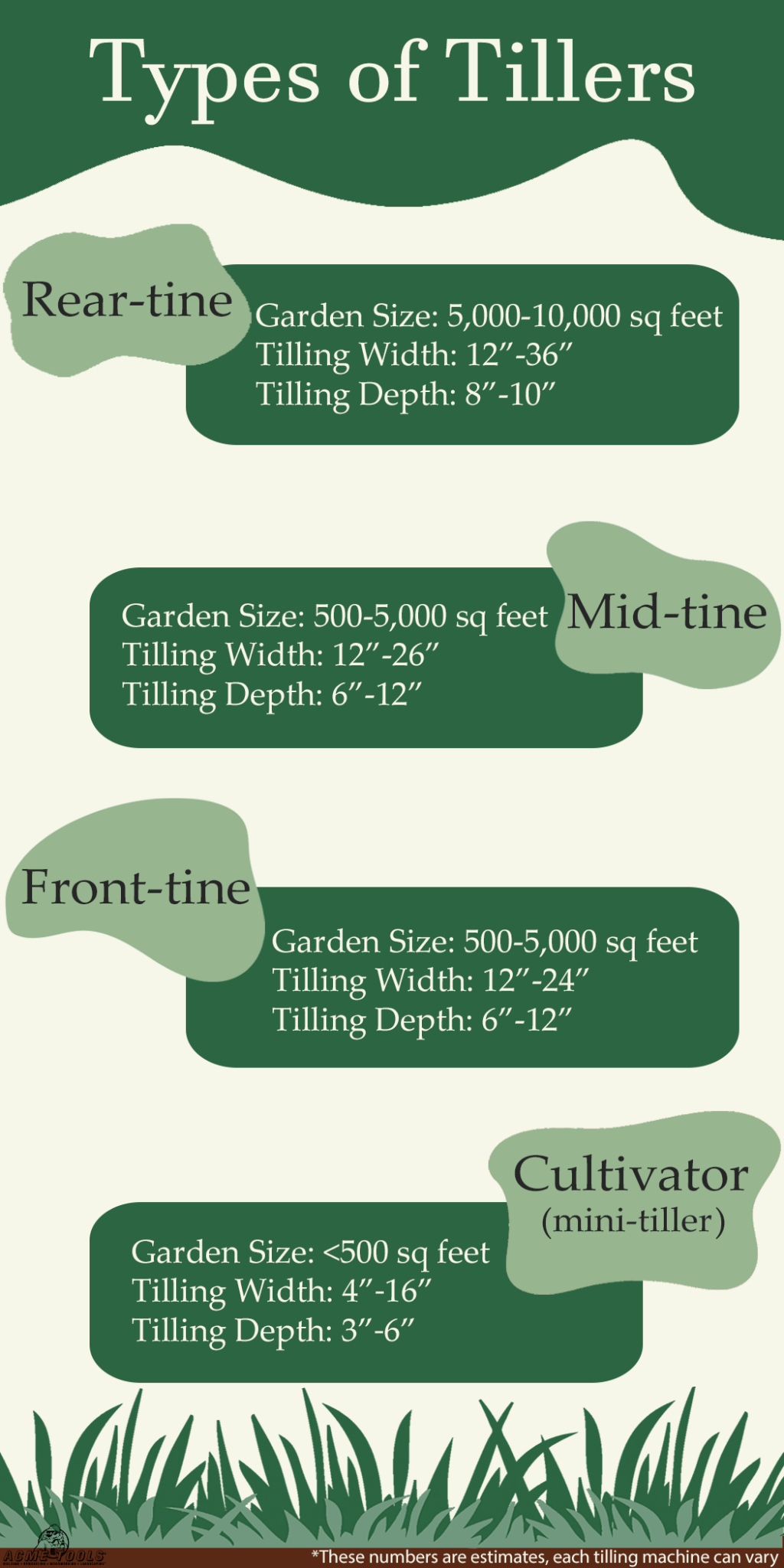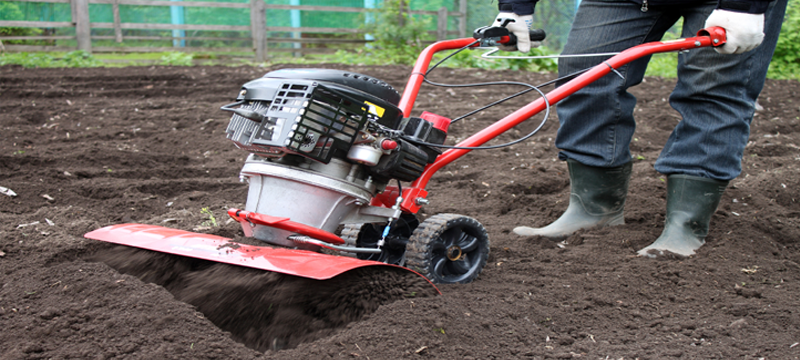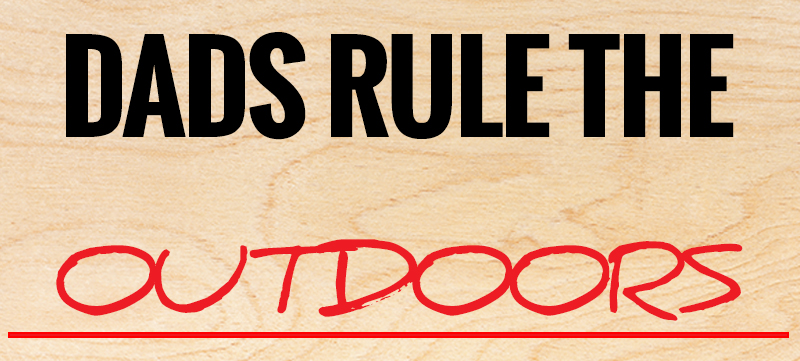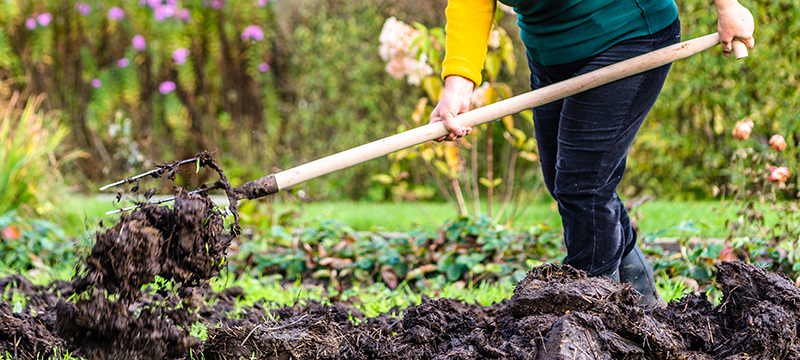With the price of groceries rising, you may consider cutting costs by planting fruits and vegetables. Regardless of what you’re growing, rich soil is required to yield healthy, plentiful produce. The easiest way to prepare your ground is to use a rototiller, also called a garden tiller, tiller, or cultivator, to break up the soil for planting. Let’s look at some essential factors to consider before purchasing a tiller.
Tiller vs. Cultivator
The terms tiller and cultivator are often used synonymously when they’re actually different tools with similar functions. While the machines look alike, they have specific gardening tasks and aren’t interchangeable. Tillers are heavier and more powerful, made for deep digging to break open hard ground. Cultivators are built for regular maintenance tasks such as incorporating fertilizer into loose soil, assisting with weeding and breaking up the top crust of the dirt for watering.
Types of Tillers
There are three main types of tillers:
- Rear Tine
- Mid-Tine
- Front Tines
Tines are metal blades that execute the digging.
Rear-tine:
Rear-tine tillers are the harder of the tilling options. They’re aggressive enough to cut through unworked ground. These machines’ tines are located on the back of the machine and offer a few options for tine rotation. Some rear-tine tillers are forward-rotating, some counter-rotating, and some offer both. They create a smoother tilling experience as they’re less likely to skip or bounce when working with rocky or harsh conditions.
Mid-tine and front-tine:
Mid-tine and front-tine tillers are more powerful than cultivators but less potent than rear-tine tillers. They’re designed to be easily maneuverable, which can be helpful when tilling narrow rows. The tines are in front of the tiller’s wheels with front-tine tillers, while tines on mid-tine tillers can be found directly beneath the engine.
Front-tine recommended: Toro Tiller Front Tine 21″ 163cc Briggs & Stratton Gas.
Mid-tine recommended: Honda 2.4HP 21In Mid-Tine Tiller

What to Consider When Purchasing a Tiller
Deciding the right tiller type is a large part of the decision-making process; however, several more factors must be considered before purchasing.
Soil Type
Where you live specifies the type of soil you’ll be working with, significantly affecting what kind of rototiller you’ll need. If the ground is more complex and contains clay and rocks, you’ll need a tiller that won’t be damaged when tilling through the more demanding job. A less powerful tiller can be used with generally soft and loose soil.
Check the soil of the area you plan to work with to better determine the rototiller type you’ll need. If you need more clarification or have further questions, visit a local tiller retailer to talk with a representative.
Tine Rotation
Different tillers have different tine rotation options. Below are a few of the more common choices:
Standard rotating tines (SRT) rotate in the same direction as the wheels and work best in soil up to five inches.
Counter-rotating tines (CRT): rotate away from the wheels, making them more powerful and easily break up more complex soils.
Dual rotating tine (DRT): rototillers with dual rotating tines offer both options.
Knowing your soil type is necessary to decide the tine rotation for the task.
Use
Once you know your soil type, you can combine that information with what you plan to use the tiller for. If you’re looking into tillers for home use and only need to break ground once, you may be able to rent a rear-tine tiller for that and get by by purchasing a less expensive front- or mid-tine model for ongoing use. For commercial tilling purposes, choosing a more powerful tiller can get jobs done quicker and easier.
Garden Size
The land size you plan to till must also be considered when buying. Smaller jobs won’t require the power and scope that large rear-tine tillers offer. Many backyard gardens will only need a smaller tiller or cultivator.
Power Source
Larger tillers are usually gas-powered, while smaller tillers and cultivators, sometimes called mini tillers, are often electric. Electric garden tillers come in both battery-powered cordless and corded options. Electric tillers are typically more affordable but less powerful.
Cost
Decide what you’ll be using your rototiller for and how often you’ll be using it. Is it something you need or want to invest money in? If the answer is no, you may get away with purchasing a less expensive option. Tillers come in a wide variety of price points depending on brand, size, and features.
Post-purchase information
Maintenance
Knowing the maintenance requirements for your tiller is essential for the longevity of your equipment. Follow all manufacturer instructions to ensure your machine works efficiently and does not need to be prematurely replaced. All tillers require cleaning between uses and frequent tine sharpening. Gas-powered tillers may have lines that need to be flushed to enhance use and lifespan.
Safety
For example, with maintenance, check the user manual to see the safest way to operate the machinery. Make sure you read the manual before using it to optimize safety. It’s also crucial to wear proper clothing and PPE gear.
Frequently Asked Questions
Should I wet the ground before using a tiller?
If the soil you’re tilling is too dry, consider adding water before planting. You can water to about 4 inches, but let the water penetrate the soil before beginning. This usually takes a day or two.
Can a rototiller remove tree roots?
Tillers cannot break up large roots.
Can I plant right after tilling?
It’s best to wait a few weeks after tilling before beginning planting. This helps the microorganisms time to settle and develop nutrients in the ground after tilling.
Shop all our rototiller and cultivator options at Acme Tools.




